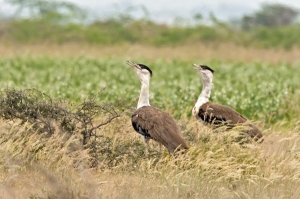A census of the Great Indian Bustard will be held this month and officials of the state forest department are getting ready for this important exercise.
According to forest officials, the 2007 census had shown that there were 48 of these Bustards in Gujarat but data collected by other nature societies had reveled their population to be less than 30. Hence, all eyes are now on this census which is taking place after six years. The officials said that the ‘direct sighting method’ will be adopted for the census in the Kutch Region ( Gujarat, India ) where the bustard is found.
This largest flying bird in the world is spotted mainly in Rajasthan, Gujarat, Maharashtra, Andhra Pradesh, Karnataka and Madhya Pradesh. Some birds are also found in Pakistan, mainly in summer.
Officials said that a meeting of villagers and forest officials will be held to finalize the programme for the census. Separate teams will be set up and posted in pockets where sightseeing has been reported.
The census will be conducted in two phases – the first will be the primary round and the second will be the main final round. Officials said that according to the union ministry of forests and environment, the bird faces several threats to its existence, including threats from the rapid development of infrastructure taking place in Kutch (Gujarat). Domestic and stray animals are also among the major threats affecting conversation efforts for the bird.
Apart from these, collision with high tension electric wires, fast moving vehicles and other man-made structures continue to be a threat in the Industrial development zones near bustard inhabited areas. Deaths of Great Indian Bustard have been reported frequently from Kutch in Gujarat and Solapur in Maharashtra.
For the bird’s conversation, the Union ministry had asked the state government to undertake scientific studies of seasonal movements of bustards and their lifecycles, regular patrolling of bustard territories and setting up of local networks to monitor the fencing around core bustard areas. Removal of dogs and other nest predators with the help of the veterinary department has also been suggested.
It was in 2005 that Dr. Bharat Pathak, currently director of Gujarat Ecological Education and Research ( GEER ) Foundation had rushed to Velavadar Blackbuck National Park in Bhavnagar ( Gujarat, India ). He had heard of a bustard sighting there.
Courtesy: - Times of India.

No comments:
Post a Comment